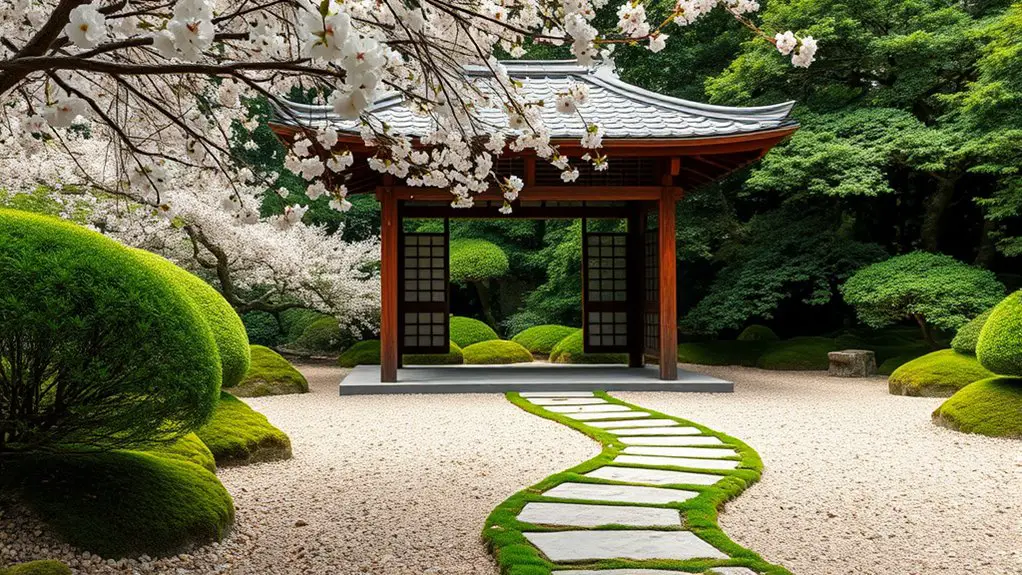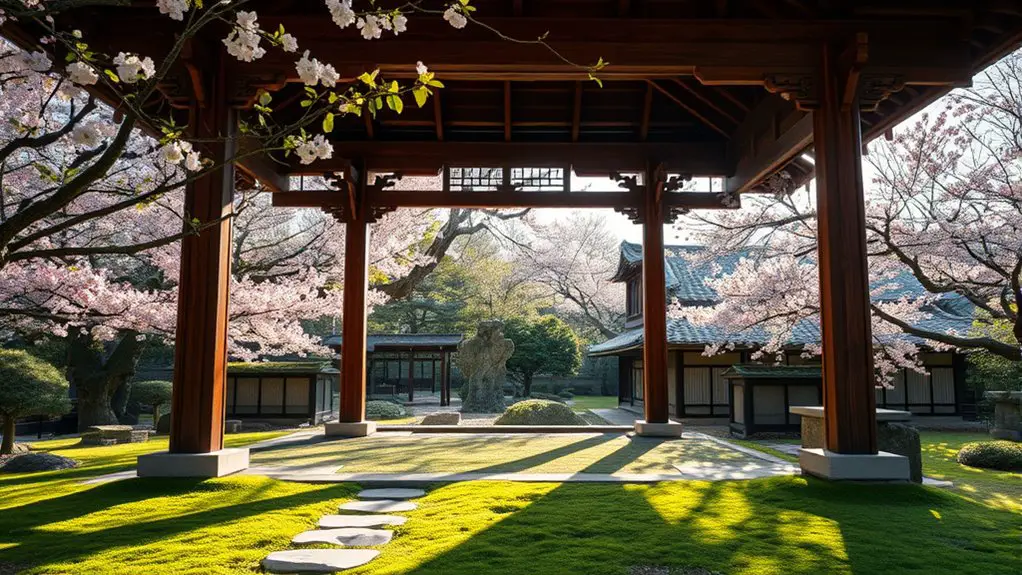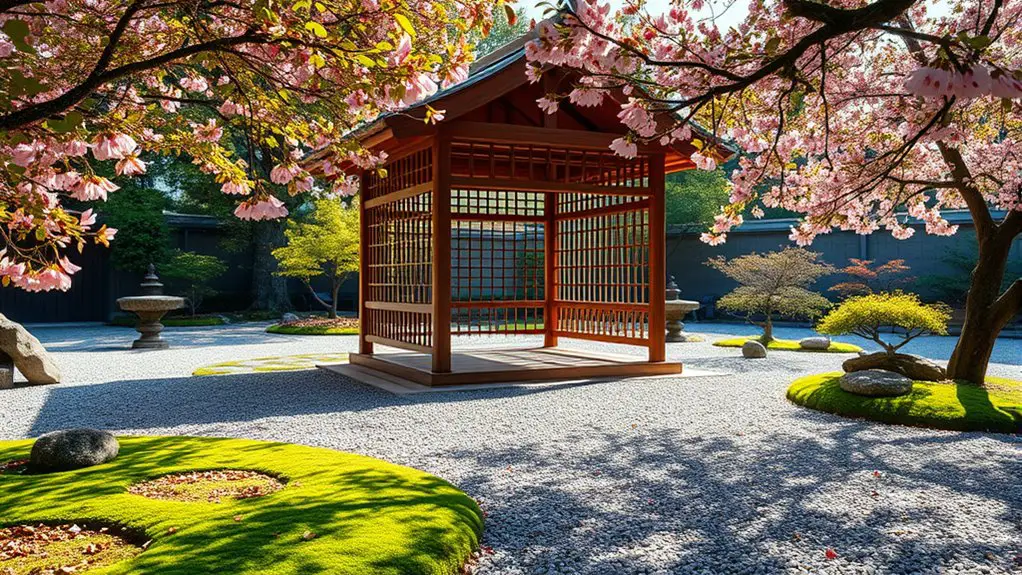To build a Japanese Zen garden gazebo, start by choosing a serene location that harmonizes with nature. Select moisture-resistant materials like cedar or bamboo for structure and roofing. Design a thoughtful layout near focal points like koi ponds, ensuring balance and tranquility. Create a sturdy foundation with concrete or piers, then assemble the gazebo, focusing on height and roof style. Finally, enhance the space with ambient lighting and natural decor to complete the peaceful aesthetic, offering a seamless retreat in your garden.
Choosing the Right Location

When you’re selecting the perfect spot for your Zen garden gazebo, it’s vital to contemplate both the aesthetic and functional aspects of the location. Start by evaluating your site selection; consider the natural landscape surrounding you. Look for a serene area that harmonizes with your garden’s elements, like gently flowing water or lush greenery.
Environmental considerations play an important role too. Make sure your gazebo gets enough sunlight without being exposed to harsh winds, as this can affect both comfort and the longevity of your structure. You might want to avoid low-lying areas prone to water accumulation, as standing water can disrupt your peaceful oasis. Additionally, ensure that the ideal placement of your gazebo takes into account factors such as privacy, sun exposure, and accessibility for a truly inviting space.
Think about accessibility as well; a balanced location allows you to enjoy your gazebo without feeling confined. With careful thought, your chosen site can transform into a sanctuary that embodies tranquility, inviting you to unwind and reconnect with nature.
Selecting Materials for Your Gazebo
Choosing the right materials for your gazebo is essential to guarantee it complements the serenity of your Zen garden while providing durability and aesthetic appeal. Start with wood types like cedar or redwood, known for their natural resistance to moisture and pests. These options not only stand the test of time but also blend beautifully with the natural surroundings.
For roofing options, consider bamboo or thatch for a traditional look, while metal or shingles can offer modern durability.
Here’s a simple comparison to help you decide:
| Wood Types | Roofing Options | Aesthetic Appeal |
|---|---|---|
| Cedar | Bamboo | Warm and inviting |
| Redwood | Thatch | Rustic and natural |
| Pressure-Treated Pine | Metal | Sleek and contemporary |
Ultimately, your choices should reflect both functionality and tranquility, enhancing the peaceful atmosphere of your Zen garden. Additionally, choosing sustainable materials like wood is a great way to contribute to an eco-friendly material choice, ensuring your gazebo is both beautiful and environmentally responsible.
Designing Your Gazebo Layout

As you envision the layout of your gazebo, consider how its placement will harmonize with the surrounding elements of your Zen garden. Think about the gazebo dimensions; a larger structure might dominate the space, while a smaller one could create a cozy retreat. Aim for a balance that encourages tranquility. Place your gazebo near a focal point, like a koi pond or a stone lantern, ensuring landscape integration that enhances both the gazebo and the garden.
Imagine pathways leading to your gazebo, guiding visitors through the serene environment. Incorporate natural features like boulders or trees to soften the edges and blend the design into the landscape. Allow for ample seating and open views, fostering an inviting atmosphere. Finally, consider the sun’s path and shadows; positioning the gazebo for ideal light can elevate the overall aesthetic while preserving the calming essence of your Zen garden. Additionally, ensure that the gazebo is easily accessible from the home to maintain convenience for guests and residents alike.
Building the Foundation
With the layout set and the gazebo’s harmonious placement in mind, it’s time to focus on building a solid foundation. A strong base guarantees stability and longevity, allowing your sanctuary to thrive. Start by considering the following foundation types based on your soil preparation:
- Concrete Slab: Ideal for uneven terrain, it provides a robust and permanent base.
- Pier Foundation: Perfect for sloped areas, it elevates your gazebo while allowing water drainage.
- Sonotube Footings: Great for lightweight structures, these cylindrical forms support your gazebo without excessive excavation.
Before laying any foundation, verify your soil is properly prepared. Clear away debris, level the ground, and compact the soil to create an even surface. This preparation sets the stage for a serene retreat that embodies the essence of tranquility and balance in your Zen garden. Additionally, ensure you consider local building codes that may dictate foundation requirements for your gazebo.
Constructing the Gazebo Structure

Constructing the gazebo structure is where your vision truly begins to take shape, transforming your foundation into a tranquil retreat. Start by determining the gazebo height; a lower profile can create a cozier feel, while a taller design may invite grandeur. Choose your roof style wisely—traditional pagoda roofs evoke elegance, while simpler gable roofs offer a modern touch.
Use quality materials like cedar or bamboo, which not only enhance aesthetics but also align with Zen principles of harmony. Assemble the vertical posts first, ensuring they’re securely anchored to your foundation. Then, connect the horizontal beams, creating a sturdy frame. As you add the roof structure, consider the angles carefully; they should complement the surrounding landscape. Additionally, consider weather resistance to ensure your gazebo withstands the elements for years to come.
This stage is where function meets beauty, so embrace your creativity. Your gazebo will soon become a serene escape, a perfect place for reflection and tranquility.
Adding Finishing Touches and Decor
Once you’ve established the sturdy frame of your gazebo, the next step is to enhance its tranquility with thoughtful finishing touches and decor. These elements not only beautify the space but also create a serene atmosphere that invites relaxation.
Consider these three ideas to elevate your gazebo:
- Lighting Options: Soft, ambient lighting can transform your gazebo at dusk. String lights or lanterns hung from the beams provide a warm glow, perfect for evening gatherings.
- Decorative Elements: Incorporate bamboo, stones, or water features to evoke a natural feel. A small fountain or stone lantern can serve as a focal point, enhancing the Zen aesthetic.
- Seating Arrangements: Opt for low, comfortable seating that encourages a laid-back vibe. Cushions in earthy tones can add both comfort and style.
Additionally, choose a steel frame gazebo for its durability and strength, ensuring that your serene space can withstand the elements over time.
With these finishing touches, your gazebo will embody the essence of a Japanese Zen garden.
Frequently Asked Questions
What Is the Best Time of Year to Build a Gazebo?
When the world awakens in spring, it’s a perfect time for construction, as nature dances with possibilities. Yet, autumn’s gentle weather offers a serene backdrop. Choose wisely; both seasons hold promise for your gazebo’s creation.
How Do I Maintain My Gazebo Over Time?
To maintain your gazebo, regular cleaning’s essential. Remove debris and mold, while structural inspections every season guarantee safety. This attention to detail preserves its beauty, allowing you to enjoy your peaceful retreats without worry.
Can I Use Alternative Materials for My Gazebo?
Absolutely, you can use alternative materials for your gazebo design. Consider bamboo or recycled metal for a unique aesthetic. These options offer durability and sustainability, allowing your creativity to flourish while harmonizing with your natural surroundings.
What Plants Complement a Japanese Zen Garden Gazebo?
To enhance your Japanese Zen garden gazebo, consider incorporating elegant bamboo varieties and lush moss types. These elements not only create tranquility but also harmonize beautifully, inviting a serene atmosphere that encourages freedom and reflection.
Are There Specific Colors That Work Best for My Gazebo?
You’d think bright colors would steal the show, but subtle hues like soft greens and browns embody color symbolism, enhancing your gazebo’s aesthetics, creating a serene atmosphere that invites tranquility and freedom within your Zen garden.

